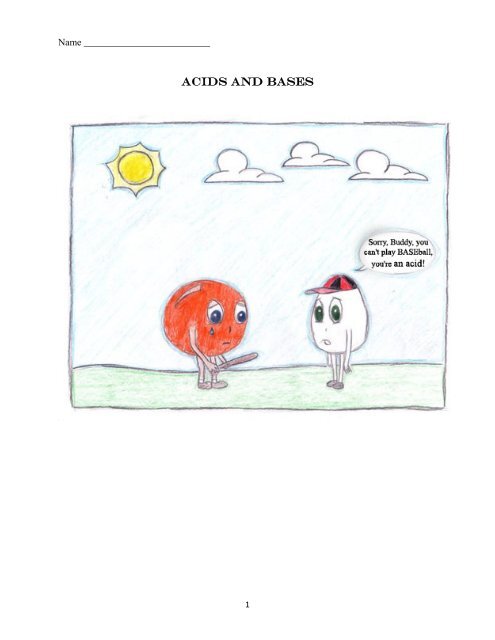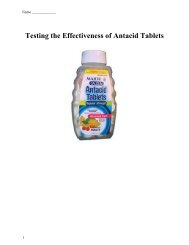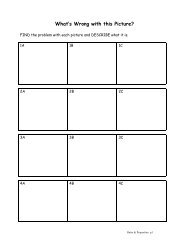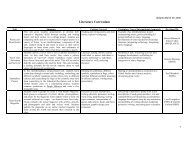ACIDS AND BASES
ACIDS AND BASES
ACIDS AND BASES
Create successful ePaper yourself
Turn your PDF publications into a flip-book with our unique Google optimized e-Paper software.
Name __________________________<br />
Acids and Bases<br />
1
Introduction to Acids<br />
With the class, view the video “Cheeseburger in Hydrochloric Acid”<br />
(http://www.youtube.com/watch?v=NddZ5ftQb0Q).<br />
BEFORE THE VIDEO<br />
What do you know about acids?<br />
What do you know about<br />
acids?<br />
AFTER THE VIDEO<br />
Explain what part of the<br />
video made you think this.<br />
DISCUSS<br />
Based on what you saw in the video, why do you think we need acids in our stomachs?<br />
______________________________________________________________________________<br />
______________________________________________________________________________<br />
______________________________________________________________________________<br />
Activity: Which are Acids?<br />
Acids are not only in our stomachs, they also are present in our houses and in our classrooms.<br />
With your table, brainstorm what common items you may use every day that could be acids.<br />
Explain why you think that.<br />
We think that _______________________________________<br />
___________________________________________________<br />
______________________________ may be acids because<br />
________________________________________________<br />
________________________________________________<br />
2
Work with your table to see if the items supplied are acids. Your table should collect<br />
approximately 10 ml samples of each of the liquids from the front of the room. Each table should<br />
also collect 7 sheets of blue litmus. Bring your materials back to your lab table.<br />
BLUE LITMUS TURNS RED WHEN IT IS IN AN ACIDIC ENVIRONMENT.<br />
Therefore, if the liquids you’re testing are acids, the BLUE litmus will turn RED.<br />
If the liquids are not acids, the BLUE litmus WILL NOT change color.<br />
Liquids from front of room:<br />
- Pineapple juice<br />
- Coconut water<br />
- Tap water<br />
- Bottled water<br />
- Ginger ale<br />
- Windex<br />
- Grapefruit juice<br />
BEFORE TESTING:<br />
Based on your table’s idea of what an acid is, which of the items that we’ll test do you expect to<br />
be acids? List them below.<br />
______________________________________________________________________________<br />
______________________________________________________________________________<br />
Why did you select these items?<br />
______________________________________________________________________________<br />
______________________________________________________________________________<br />
AFTER TESTING:<br />
Which of the liquids are actually acids? List them below.<br />
______________________________________________________________________________<br />
______________________________________________________________________________<br />
Which of the liquids were surprising? Explain why.<br />
______________________________________________________________________________<br />
______________________________________________________________________________<br />
______________________________________________________________________________<br />
______________________________________________________________________________<br />
______________________________________________________________________________<br />
3
Acids and Bases<br />
Most of the liquids that you see have either acidic of basic properties. We know some<br />
information about acids, but what is a base?? The following readings tell you more information<br />
about acids and bases. Read each section aloud with your reading partner, one section at a time.<br />
The readings on pages 4 – 8 are from:<br />
Carpi, A. PhD. “Acids and Bases: An Introduction”. Visionlearning Vol. CHE-2 (2), 2003.<br />
http://www.visionlearning.com/library/module_viewer.php?mid=58<br />
Define sour:<br />
Read SECTION ONE aloud with a partner and complete the Venn Diagram on page 4 with<br />
quotes and information from the reading about acids and bases.<br />
SECTION ONE:<br />
Translate or draw<br />
example:<br />
For thousands of years people have known that vinegar, lemon juice, and many<br />
other foods taste sour. However, it was not until a few hundred years ago that it<br />
was discovered why these things taste sour – because they are all acids. The term<br />
acid, in fact, comes from the Latin term acere, which means “sour”.<br />
Define corrosive:<br />
In the seventeenth century, the Irish writer and amateur chemist Robert Boyle<br />
first labeled substances as either acids or bases (bases are also called alkaline)<br />
according to the following characteristics:<br />
Acids: taste sour, are corrosive to metals, turn litmus (a dye extracted<br />
from lichens) red, and become less acidic when mixed with bases.<br />
Bases: feel slippery, turn litmus blue, and become less basic when<br />
mixed with acids.<br />
Translate or draw example:<br />
In the 1800s Swedish scientist Svante Arrhenius proposed that water can<br />
dissolve many compounds by separating them into their individual ions.<br />
Arrhenius suggested that acids are compounds that contain hydrogen and<br />
can dissolve in water to release hydrogen ions into solution. For example,<br />
hydrochloric acid (HCl) dissolves in water as follows:<br />
Draw a sketch of dissolve:<br />
HCl H+ + Cl-<br />
Arrhenius defined bases as substances that dissolve in water to release hydroxide ions (OH-) into<br />
solution. For example, a typical base according to the Arrhenius definition is sodium hydroxide<br />
(NaOH):<br />
NaOH Na+ + OH-<br />
All acids release H+ ion in solution and all bases release OH- ions in solution.<br />
4
Complete the Venn Diagram below with quotes and information from SECTION ONE.<br />
<strong>ACIDS</strong><br />
<strong>BASES</strong><br />
5
After reading SECTION TWO, complete the different stages of what’s happening in the<br />
neutralization reactions provided. Explain each of the four stages of the neutralization reaction.<br />
SECTION TWO<br />
Neutralization:<br />
As you can see from the equations, acids release H+ into solution and bases release OH-. If we<br />
were to mix an acid and base together, the H+ ion would combine with the OH- ion to make the<br />
molecule H2O.<br />
H + + OH - H20<br />
A neutralization reaction with an acid and a base will always produce water and a salt, as shown<br />
below:<br />
Two examples:<br />
First example:<br />
Second example:<br />
Acid Base Water Salt<br />
HCl + NaOH H20 + NaCl<br />
HBr + KOH H20 + KBr<br />
Read the section below for the first neutralization reaction:<br />
Stage 1:<br />
HCl + NaOH<br />
Stage 2:<br />
Stage 3:<br />
Stage 4:<br />
HCl + NaOH<br />
H + and Cl - + Na + and OH - H20 + NaCl<br />
H + and Cl - + Na + and OH -<br />
Explanation: Explanation: Explanation:<br />
Explanation:<br />
HCl and NaOH<br />
are combined<br />
together. HCl is<br />
an acid and<br />
NaOH is a base.<br />
Since HCl is an acid, it releases<br />
H+ ion in solution. Cl- is the<br />
other ion that HCl dissociates<br />
(or breaks) into.<br />
Since NaOH is a base, it releases<br />
OH- ion in solution. Na+ is the<br />
other ion that NaOH dissociates<br />
(or breaks) into.<br />
H+ and OH- combine and<br />
Na+ and Cl- combine.<br />
H+ and OH- form H2O.<br />
Na+ and Cl- form NaCl.<br />
H20 is water and NaCl<br />
is a salt. Therefore, the<br />
acid and base combined<br />
to form a salt and water.<br />
6
Complete the stages for the second example of a neutralization reaction.<br />
Stage 1:<br />
Stage 2:<br />
Stage 3:<br />
Stage 4:<br />
HBr + KOH<br />
HBr + KOH<br />
___ and ___ + ___ and ___<br />
__ and __ + __and __<br />
________________<br />
Explanation:<br />
Explanation: Explanation: Explanation:<br />
____ and _____<br />
are combined<br />
together. ____ is<br />
an acid and<br />
_____ is a base.<br />
Since ____is an acid, it releases<br />
______ in solution. ____ is the<br />
other ion that _____ dissociates<br />
(or breaks) into.<br />
Since _____ is a base, it releases<br />
______ ion in solution. ______<br />
is the other ion that ______<br />
dissociates (or breaks) into.<br />
_____ and _____ combine<br />
and ______ and _____<br />
combine.<br />
____ and _____ form<br />
______. ______ and<br />
____ form _____.<br />
_____ is water and<br />
_____ is a salt.<br />
Therefore, the acid and<br />
base combined to form<br />
______ and _____.<br />
After reading SECTION THREE, write a two sentence summary that explains the difference<br />
between Arrhenius’ and Bronsted-Lowery’s theories of acids and bases.<br />
SECTION THREE:<br />
Though Arrhenius helped explain the fundamentals of acid/base chemistry, unfortunately his<br />
theories have limits. For example, the Arrhenius definition does not explain why some<br />
substances, such as common baking soda (NaHCO3), can act like a base even though they do not<br />
contain OH- ions.<br />
In 1923, the Danish scientist Johannes Bronsted and the Englishman Thomas Lowery published<br />
independent yet similar papers that refined Arrhenius’ theory. They said that acids release H+<br />
ion in solution and that bases take up H+ ion in solution.<br />
Under the Bronsted-Lowery definition, both acids and bases are related to the concentration of<br />
hydrogen ions present. Acids increase the concentration of hydrogen ions, while bases decrease<br />
the concentration of hydrogen ions (by accepting them).<br />
Acid Base Salt<br />
HCl + NaHCO3 H2CO3 + NaCl<br />
Two sentence explanation of differences in Arrhenius’ and Bronsted-Lowery’s acid/base<br />
theories:<br />
______________________________________________________________________________<br />
______________________________________________________________________________<br />
7
______________________________________________________________________________<br />
______________________________________________________________________________<br />
Based on the reading, where did Arrhenius’ theory fall short?<br />
Answer<br />
Quote from reading that let you know this<br />
I know this<br />
because<br />
Read SECTION FOUR. Think of what this means about the substances that you tested in the<br />
beginning activity of this packet. What are the pH values of the substances that we tested in our<br />
first activity?<br />
SECTION FOUR:<br />
pH<br />
In 1909 the pH scale was invented. The pH scale measures the concentration of hydrogen ion in<br />
the solution. The pH scale ranges from 0 to 14. Substances with a pH between 0 and less than 7<br />
are acids. Substances with a pH greater than 7 and up to 14 are bases. Right in the middle, at pH<br />
= 7, are neutral substances, for example, pure water.<br />
Strong acids are measured on the pH scale as having a pH closer to 0. Strong bases are measured<br />
on the pH scale as having a pH closer to 14.<br />
<strong>ACIDS</strong><br />
<strong>BASES</strong><br />
8
Therefore, what is the range of pH levels for the liquids that we tested in the beginning activity<br />
of this packet?<br />
______________________________________________________________________________<br />
_____________________________________________________________________________<br />
Go back to reading SECTION FOUR and underline the phrase(s) that let you know that.<br />
Create a flash card for each of the following words that were used in the<br />
readings.<br />
On the front of the flash card write the word and draw a picture.<br />
On the back of the flash card, write the definition and the quote from the<br />
reading where the word was explained.<br />
• Acid (noun)<br />
• Base (noun)<br />
• Neutral (noun)<br />
• Neutralization Reaction (noun)<br />
• pH Scale (noun)<br />
Work with your reading partner to quiz each other with your flash cards.<br />
Lab: Testing common liquids to classify as acids or bases<br />
Question: Which is the strongest acid and which is the strongest base from the following items?<br />
Pepsi<br />
Dish soap<br />
Hand soap<br />
Vinegar<br />
Apple Juice<br />
Orange Juice<br />
Introduction: Various household items that we use and come into contact with everyday are<br />
different levels on the pH scale. We use acids and bases every day. As you already know, the pH<br />
scale is a way to measure how acidic or alkaline a substance is. In the lab, pH paper tells us the<br />
pH of a liquid. All we need to do is hold the pH paper in the liquid for 15 second and it changes<br />
color. We use the color code that the teacher will hand out to let us know what pH the liquid is<br />
based on the color of the pH paper.<br />
9
Hypothesis:<br />
Make sure that your hypothesis is written in an “If…then…” format.<br />
For example:<br />
If I test the given items to see which is the strongest acid and which is the strongest base, then<br />
_____ will be the strongest acid and ______ will be the strongest base.<br />
If ________________________________________________________________<br />
______________________________________________ __________ then<br />
________________ will be the strongest acid and<br />
____________________ will be the strongest base.<br />
Why?<br />
Go back to our reading on pages 4 – 8 and justify your hypothesis below.<br />
I think this is true because of the information from<br />
_________________________ that says _____________________________<br />
__________________________________________________________________<br />
_________________________. That makes me think that __________<br />
__________________________________________________________________<br />
__________________________________________________________________.<br />
Materials:<br />
Small cups, pH paper, paper towels, pH paper strips<br />
Procedure:<br />
1. Obtain a small cup with each of the liquids to be tested from the front of the room for<br />
your table.<br />
2. Get one piece of pH paper for each liquid to be tested.<br />
3. Dip the pH paper in the liquid and hold it there for 15 seconds.<br />
4. Take the pH paper out of the liquid after 15 seconds.<br />
5. Use the key on the pH label to record the pH in your data chart.<br />
10
Data:<br />
Liquid<br />
pH<br />
Conclusion:<br />
1. Was your hypothesis supported? Explain why or why not.<br />
According to the data collected, my hypothesis ____________<br />
supported because my hypothesis said that _________________<br />
_________________________________________________________________.<br />
The data collected suggest that _____________________________<br />
_________________________________________________________________<br />
_________________________________________________________________.<br />
I know this because ___________________________________________<br />
__________________________________________________________________.<br />
2. Create a pH scale below and put the liquids where they belong on the scale.<br />
0 7 14<br />
11
Solutions:<br />
Acids and bases are often found in a solution with water. Water is the solvent and the acid or<br />
base is the solute. Together, a solute and solvent make a solution. The solute is the substance<br />
that is being dissolved and the solvent is the liquid that is dissolving the solute.<br />
Use the paragraph above to draw your own example of a solution.<br />
Label the SOLUTE and the SOLVENT.<br />
Underline the phrases in the paragraph above that told you the information you needed to know<br />
about the solute and solvent in a solution.<br />
Think:<br />
What solutions have you seen at home? Write them below and tell why you think each is a<br />
solution. Also tell what you think the solutes and solvents are.<br />
At home, I’ve seen the following solutions: _____________________<br />
________________________________________________________<br />
_______________. I believe that they’re solutions because ________<br />
________________________________________________________.<br />
I believe that the solvents are________________________________<br />
_________________________ and that the solutes are___________<br />
________________________________________________________.<br />
12
Share your thought bubble with your table. Listen to your table’s thoughts.<br />
What new solutions did you hear of from your table? Write them below and tell whether you<br />
agree or disagree with them and why.<br />
Examples of solutions I heard from my table<br />
1.<br />
I agree/disagree because…<br />
I _______ because ____________________________<br />
___________________________________________.<br />
2.<br />
I _______ because ____________________________<br />
___________________________________________.<br />
3.<br />
I _______ because ____________________________<br />
___________________________________________.<br />
Understanding Concentration of Solutions<br />
Activity 1<br />
In this activity you will create different solutions of salt water.<br />
________ IS YOUR SOLUTE <strong>AND</strong> ______ IS THE SOLVENT.<br />
What will happen to the solution when you double and triple the amount of solute?<br />
Work with your activity partner to sketch what you think the solution will look at after adding<br />
the first10 ml of salt, after adding another 10 ml of salt, and after adding a third 10 ml of salt.<br />
Solution of 100 ml of water<br />
and 10 ml of salt<br />
Solution of 100 ml of water and<br />
20 ml of salt<br />
Solution of 100 ml of water and 30<br />
ml of salt<br />
Explain Explain Explain<br />
13
Materials:<br />
Salt, water, small beaker, large beaker<br />
Procedure:<br />
1. Get a small and large beaker and bring them to your lab station.<br />
2. Fill the large beaker with 100 ml of water<br />
3. Measure 10 ml of salt with your small beaker<br />
4. Pour it and mix it into your large beaker with the water.<br />
5. Fill in your observation chart in the data section.<br />
6. Measure another 10 ml of salt with your beaker.<br />
7. Pour it and mix it into your large beaker with the salt water.<br />
8. Fill in your observation chart in the data section.<br />
Data:<br />
Qualitative observations<br />
(sketch the solution and explain what you see)<br />
Quantitative observations (what is<br />
the resulting volume?)<br />
After 10 ml of salt<br />
After another 10 ml of salt<br />
(20 ml of salt total)<br />
After another 10 ml of salt<br />
(30 ml of salt total)<br />
14
Activity 2<br />
In this activity you and your partner will use food coloring to create different concentrations of<br />
solutions.<br />
What is the solute in this activity? ___________________________<br />
Why do you think that? _________________________________________________________<br />
______________________________________________________________________________<br />
What is the solvent in this activity? ___________________________<br />
Why do you think that? _________________________________________________________<br />
______________________________________________________________________________<br />
What do you think will happen as you add more food coloring to<br />
the water?<br />
_______________________________________________________<br />
_______________________________________________________<br />
_______________________________________________________<br />
__________________________________________<br />
Materials:<br />
Food coloring, water, small beaker<br />
Procedure:<br />
1. Get a small beaker and bring them to your lab station.<br />
2. Fill the large beaker with 10 ml of water<br />
3. Add five drops of food coloring into the water. Stir.<br />
4. Observe and write your observations in the data table.<br />
5. Add another five drops of food coloring into the water. Stir.<br />
6. Observe and write your observations in the data table.<br />
7. Add another five drops of food coloring into the water. Stir.<br />
8. Observe and write your observations in the data table.<br />
15
Data:<br />
10 ml of water and 5 drops of<br />
coloring<br />
10 ml of water and 10 drops of<br />
coloring<br />
10 ml of water and 15 drops of<br />
coloring<br />
Sketch what you saw Sketch what you saw Sketch what you saw<br />
Explain what you saw Explain what you saw Explain what you saw<br />
Conclusions:<br />
1. Concentration<br />
a. Define:<br />
__________________________________________________________________<br />
__________________________________________________________________<br />
b. Translate into native language:<br />
__________________________________________<br />
c. Use the word concentration to write a sentence explaining what happened in this<br />
lab.<br />
__________________________________________________________________<br />
__________________________________________________________________<br />
__________________________________________________________________<br />
2. What salt solution was the most concentrated?<br />
What qualitative and quantitative observations let you know that was true? Write them<br />
below.<br />
3. Complete the sentence:<br />
The final solution of food coloring, with 15 drops of coloring,<br />
was _________ times more concentrated than the first solution<br />
with only 5 drops of food coloring. I know this because<br />
16
________________________________________________________________________<br />
________________________________________________________________________<br />
The second solution of food coloring, with 10 drops of coloring,<br />
was _______ times more concentrated than the first solution with<br />
only 5 drops of food coloring. I know this because<br />
________________________________________________________________________<br />
________________________________________________________________________<br />
Concentration of Acids and Bases:<br />
MOLARITY is a measure of concentration used for acids and bases. When scientists talk about<br />
concentration of an acid or base, they use the value of MOLARITY.<br />
Molarity tells you the concentration of a solute in a solvent.<br />
Molarity (M) = moles of solute<br />
liters of solvent<br />
Think back to our previous work before this packet.<br />
What is a mole? _______________________________________________________________<br />
____________________________________________________________________________<br />
Draw a representation of a mole:<br />
What is a liter? _______________________________________________________________<br />
___________________________________________________________________________<br />
Draw a representation of a liter:<br />
17
Create a flash card for each of the following words that were used in the<br />
previous sections.<br />
On the front of the flash card write the word.<br />
On the back of the flash card, write the definition and the quote from the<br />
reading where the word was explained.<br />
• Solute (noun)<br />
• Solvent (noun)<br />
• Solution (noun)<br />
• Molarity (noun)<br />
• Mole (noun)<br />
• Liter (noun)<br />
Work with your activity partner to quiz each other with your flash cards. Use your first flash<br />
cards, too.<br />
Examples using the value of Molarity:<br />
1. There is a solution of HCl.<br />
a. What is the solute in this example? How do you know that?<br />
b. What is the solvent in this example? How do you know that?<br />
c. What is the molarity of the HCl solution if there are 2 moles of HCl and 10 liters<br />
of water?<br />
2. There is a solution of NaOH.<br />
a. What is the solute? How do you know?<br />
b. What is the solvent? How do you know?<br />
c. What is the molarity of the basic NaOH solution if there are 4 moles of NaOH<br />
dissolved in 25 liters of water?<br />
18
3. What is the molarity of an acidic solution of HF if there are 2 moles of HF dissolved in<br />
50 liters of water?<br />
4. How is concentration related to molarity?<br />
If you had two salt water solutions and you didn’t know which one was more concentrated, how<br />
could you test it?<br />
______________________________________________________________________________<br />
______________________________________________________________________________<br />
______________________________________________________________________________<br />
If you had an acid or base solution that you didn’t know the molarity of it, how could you test it?<br />
Scientists use a lab procedure called a TITRATION to find the molarity of acids and bases that<br />
they don’t know.<br />
Why may it be important to know the concentration of an acid or base in a science lab?<br />
______________________________________________________________________________<br />
______________________________________________________________________________<br />
______________________________________________________________________________<br />
19
Reading: Acid-Base Titrations<br />
The reading was taken from:<br />
“Acid-Base Titrations”. Retrieved on October 2, 2011 from<br />
http://www.mpcfaculty.net/mark_bishop/titration.pdf<br />
As you read, circle key words. Only circle the words that you need to retell the important<br />
information from the reading. You will reconstruct the information from this text after reading it.<br />
20
Add the vocabulary words above to your flash cards. Draw a picture of each on<br />
the back of the flash card. Work with your reading partner to quiz each other on<br />
your flash card.<br />
1. Share the words that you circled with your partner. Work together to select a total of 20<br />
words from the reading that are the key words. Go back to the reading and highlight those<br />
words with a highlighter.<br />
2. Work with your partner to reconstruct the meaning from the text above by using only the<br />
20 words that you selected. Draw arrows, symbols, and pictures to help explain the<br />
information.<br />
22
3. Write two of the most important facts that you learned from the article above. Next to<br />
each fact, write the quote from the reading that supports the fact. Go back to the reading<br />
and underline the quote as well.<br />
Facts:<br />
Quotes:<br />
23
Lab: Acid-Base Titration<br />
In this lab activity, you’re going to work with your lab partner and use a TITRATION to find out<br />
the Molarity of an HCl solution that has an unknown Molarity.<br />
Question for this lab: What is the Molarity of the unknown HCl solution provided to you?<br />
Introduction:<br />
In this lab, we’re going to use a titration in order to find out the concentration of an unknown<br />
HCl solution. We will use NaOH to titrate our HCl solution.<br />
In the diagram below, label where the HCl and NaOH will be. Remember that the HCl is the<br />
unknown concentration.<br />
The titrant in this burette is<br />
___________<br />
This flask contains the solution of<br />
_____________ to be titrated and<br />
also contains the indicator.<br />
24
The indicator that we will use in this lab is phenolphthalein. It will turn pink when the HCl<br />
solution in the flask becomes the slightest bit basic. The HCl will become basic because we’re<br />
adding NaOH slowly from the burette.<br />
Remember that an acid and a base make salt and water when they’re added together. That means<br />
that the HCl in the flask and the NaOH in the burette make NaCl and H2O when they meet in the<br />
flask. As this is happening, the phenolphthalein is still clear in the flask.<br />
However, once you add a drop of base more than the HCl in the flask, the flask becomes basic.<br />
Then, the flask turns pink because phenolphthalein turns pink when it’s in a basic solution.<br />
Summarize the information above in two sentences and retell it<br />
to your lab partner.<br />
____________________________________________________<br />
____________________________________________________<br />
____________________________________________________ After<br />
____________________________________________________ sharing<br />
____________________________________________________<br />
____________________________<br />
What information did your lab partner write<br />
that you didn’t include but is important?<br />
_____________________________________<br />
_____________________________________<br />
_____________________________________<br />
_____________________________________<br />
You will use the following formula to solve for the Molarity of the unknown HCl solution.<br />
M A = Unknown Molarity of the acid<br />
V A = Volume of the acid that was added to the flask<br />
M B = Known Molarity of the base<br />
V B = Volume of the base that was added from the burette to the flask<br />
25
Watch your teacher perform the sample titration. After watching her, work with your lab partner<br />
to explain why each step is important.<br />
Step<br />
Check that there are no<br />
bubbles trapped in the<br />
opening of the burette before<br />
you begin the titration.<br />
Draw a picture of what this<br />
means<br />
Why is this important?<br />
Swirl the flask as you add the<br />
NaOH from the burette.<br />
Add the NaOH very slowly<br />
from the burette. Stop once<br />
the flask is very slightly pink.<br />
Write a balanced equation for the neutralization of hydrochloric acid by sodium hydroxide.<br />
Materials:<br />
Erlenmeyer flask, ring stand, burette, NaOH, HCl, phenolphthalein, water, graduated<br />
cylinder, beaker<br />
Safety:<br />
During this lab you must wear gloves and goggles at all times! If you spill HCl or NaOH anywhere, notify<br />
your teacher immediately. If you get any acid or base on your gloves, immediately wash your gloves to<br />
rinse the acid off – then throw the gloves away and continue washing your hands for 30 seconds.<br />
Roll all long-sleeves up and tie back long hair.<br />
26
Procedure:<br />
Get NaOH solution into your burette:<br />
1. Measure 40 ml of NaOH into a beaker carefully.<br />
2. Take a funnel and the beaker with NaOH back to your lab station.<br />
3. Lower the burette down to eyelevel. Have a partner hold the burette to make sure it is<br />
secured in the holder.<br />
4. Use the funnel to transfer the NaOH into the burette.<br />
5. Run the NaOH out into the beaker until it’s at the 20 ml mark on the burette – which<br />
means that there are 30 ml of NaOH in the burette.<br />
6. Put the burette back to titration height.<br />
Get a solution of HCl and water into your Erlenmeyer flask:<br />
1. Measure 20 ml of H 2 O into a graduated cylinder carefully.<br />
2. Transfer the 20 ml of H 2 O into an Erlenmeyer flask.<br />
3. Measure 20 ml of HCl from the burette in the front of the room into a beaker.<br />
4. Transfer the 20 ml of HCl into the Erlenmeyer flask that holds the water.<br />
5. Place the Erlenmeyer flask in a safe location on your table.<br />
Add indicator:<br />
1. Add three drops of phenylalanine into the Erlenmeyer flask with the acid and water.<br />
Titration background:<br />
1. Place a white index card under the Erlenmeyer flask. This will help you see when you<br />
reach the endpoint.<br />
Titration:<br />
1. Add the NaOH into the HCl slowly while swirling the Erlenmeyer flask.<br />
2. Your endpoint is when a pink color persists in the Erlenmeyer flask for 15 seconds.<br />
3. You do not want to over-titrate the solution. If you have a deep pink color that is<br />
permanent, then you over-titrated.<br />
Cleaning up lab station:<br />
Put your waste into the beakers labeled “acid waste” and “base waste”. Do not dump your<br />
solutions down the drain.<br />
To get the base waste from your burette, empty it into the beaker that you used to fill the burette.<br />
27
Data:<br />
Your data<br />
Class Average<br />
Volume of HCl used _________ ml _________ ml<br />
Initial NaOH burette reading<br />
_________ ml<br />
Ending NaOH burette reading<br />
_________ ml<br />
Volume of NaOH added _________ ml _________ ml<br />
Molarity of NaOH 0.1 M 0.1 M<br />
Calculations:<br />
Find the Molarity of HCl based on the class average and the formula in your introduction<br />
section.<br />
Questions:<br />
1. What is the molar mass of HCl? Explain in words how you know. (Go back to the<br />
previous packet if you need to remind yourself what molar mass is).<br />
2. How many moles of HCl were in the 20 ml of HCl that we used? Explain in words how<br />
you know.<br />
28
3. Your stomach acid contains 0.1 M HCl. Why do you think this may be?<br />
Research: Why is a human’s stomach acidic?<br />
Website citation:<br />
How do you know this is a reliable website?<br />
Based on the website, why do humans have an<br />
acidic environment in their stomachs?<br />
What quotes from the reading tell you that?<br />
Write them below.<br />
Round Robin:<br />
Share your answers with your table. Go around and everyone at your table should share their<br />
novel ideas.<br />
What new information did you hear from your table partners? Write them below.<br />
______________________________________________________________________________<br />
______________________________________________________________________________<br />
______________________________________________________________________________<br />
______________________________________________________________________________<br />
29
Vocabulary Mobile:<br />
Go back through this packet and select two more important vocabulary words to create<br />
flashcards for.<br />
Include the word and a picture on the front and the definition and sentence from this packet<br />
where the word is used on the back.<br />
With your table, select different flashcards from what you have and create a vocabulary mobile<br />
out of popsicle sticks, wooden skewers, and string.<br />
Hang your mobile where your table can view the words.<br />
30









